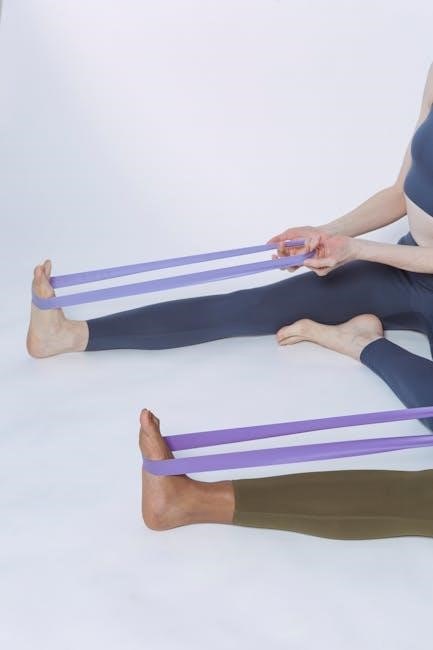IT Band Syndrome, or iliotibial band syndrome, is a common overuse injury causing lateral knee pain, often seen in runners and cyclists due to repetitive knee flexion.
1.1 Definition and Overview
IT Band Syndrome (ITBS) is an overuse injury characterized by inflammation and irritation of the iliotibial band, a fibrous ligament running along the outer thigh. It causes lateral knee pain, particularly during activities like running or cycling. The IT band friction syndrome occurs when the band rubs against the lateral femoral condyle, often due to repetitive knee flexion and extension. This condition is prevalent among athletes and individuals engaged in repetitive knee movements, leading to discomfort and limited mobility if left untreated. Early intervention through stretching and strengthening exercises is crucial for recovery.
1.2 Prevalence in Athletes and Active Individuals
IT Band Syndrome is highly prevalent among athletes, particularly runners, cyclists, and those involved in sports requiring repetitive knee flexion. Studies indicate that runners are especially susceptible, with incidence rates ranging from 5% to 14%. Active individuals who suddenly increase their training intensity or mileage are at higher risk. The condition is also common in triathletes and hikers due to prolonged repetitive movements. Proper training, stretching, and equipment adjustments can significantly reduce the likelihood of developing ITBS in these populations. Early recognition and intervention are key to preventing long-term discomfort and performance limitations.

Symptoms and Diagnosis
IT Band Syndrome often presents with pain on the outside of the knee, especially during activities like running or cycling. Swelling and tenderness may accompany this discomfort.
2.1 Common Symptoms of IT Band Syndrome
IT Band Syndrome typically causes pain on the outside of the knee, especially during activities like running or cycling. Swelling and tenderness may also occur.
Pain often worsens with repetitive knee movements, such as climbing stairs or squatting. Some individuals may experience a sharp, stabbing pain, while others feel a dull ache. The discomfort usually subsides with rest but returns with resumed activity. If left untreated, the pain can progress, making everyday movements uncomfortable. Early recognition of these symptoms is crucial for effective management and recovery.
2.2 Diagnostic Considerations and Medical Evaluation
Diagnosis of IT Band Syndrome is primarily clinical, relying on physical examination and patient history. Key findings include tenderness along the lateral thigh and knee, particularly over the lateral femoral condyle. Pain is often reproduced with specific maneuvers, such as knee flexion at 30 degrees or direct palpation of the IT band. Imaging, like MRI or ultrasound, may be used to rule out other conditions. A thorough medical evaluation ensures accurate diagnosis, distinguishing ITBS from other causes of knee pain, and guides appropriate treatment.

Risk Factors and Causes
IT Band Syndrome is often caused by overuse injuries, repetitive knee flexion, and weakness in hip and core muscles. Poor running form and biomechanical issues also contribute.
3.1 Overuse Injuries and Repetitive Knee Flexion
Overuse injuries and repetitive knee flexion are primary causes of IT Band Syndrome. Activities like running, cycling, or repetitive knee bending lead to inflammation and irritation of the iliotibial band. This occurs when the IT band repeatedly rubs against the lateral femoral condyle, especially during knee flexion at around 30 degrees. Prolonged or intense activity exacerbates the condition, causing pain and swelling on the outside of the knee. Rest and activity modification are crucial to prevent further aggravation and promote recovery.
3.2 Weakness in Hip and Core Muscles
Weakness in the hip and core muscles often contributes to IT Band Syndrome. When these muscles are underdeveloped, they fail to stabilize the pelvis and knee during movement, leading to poor biomechanics. This instability causes increased stress on the IT band, resulting in irritation and pain. Strengthening exercises targeting the glutes, hip abductors, and core can help restore proper alignment and reduce strain on the IT band, addressing the root cause of the syndrome and preventing recurrence.
3.4 Running Form and Biomechanical Issues
Running form and biomechanical issues significantly contribute to IT Band Syndrome. Overstriding, excessive heel striking, and poor knee alignment during running can increase stress on the IT band. Additionally, factors like leg length discrepancies or improper footwear can alter running mechanics, leading to repetitive friction and irritation of the IT band. Addressing these biomechanical flaws through gait analysis, proper footwear selection, and technique corrections can help mitigate the risk of developing IT Band Syndrome and improve overall running efficiency.

Stretching Exercises for IT Band Syndrome
Stretching exercises target the IT band and surrounding muscles to reduce tightness and alleviate pain. Common stretches include standing, figure-four, and side-lying IT band stretches.

4.1 Standing IT Band Stretch
The standing IT band stretch is performed by crossing the affected leg behind the other while standing. Lean away from the affected side until a stretch is felt on the outer thigh. Hold for 30 seconds, repeat 3 times daily. This stretch targets the IT band and piriformis muscle, improving flexibility and reducing tension. It’s often recommended for runners and cyclists to incorporate this stretch into their routine to prevent IT band syndrome.
4.2 Figure-Four Stretch for IT Band and Piriformis
Lie on your back with the affected leg crossed over the other, forming a “figure-four” position. Gently lean forward to feel a stretch along the outer thigh and buttock. Hold for 30 seconds, then repeat 3 times. This stretch effectively targets both the IT band and piriformis muscle, relieving tightness and improving flexibility. It’s particularly beneficial for runners and cyclists to incorporate into their routine to address IT band syndrome and prevent discomfort during physical activity.
4.3 Side Lying IT Band Stretch
Lie on your side with the affected leg on top. Cross the top leg over the bottom thigh, keeping the foot flexed. Gently lean forward until you feel a stretch along the outer thigh. Hold for 30 seconds, then repeat 3 times. This stretch targets the IT band and is ideal for individuals who find standing stretches challenging. It’s a gentle yet effective way to improve flexibility and reduce tension in the lateral thigh, especially for runners or cyclists dealing with IT band syndrome.

Strengthening Exercises
Strengthening exercises focus on improving hip and core stability to reduce IT band tension. Include glute bridges, lateral walks, and hip abductions. Perform 3 sets of 15 reps.
5.1 Hip Abduction and Glute Strengthening
Hip abduction and glute strengthening exercises are essential for addressing IT band syndrome. Weakness in these areas often contributes to poor running form and increased stress on the IT band. Exercises like side-lying leg lifts, clamshells, and banded lateral walks target the gluteus medius and minimus. Perform 3 sets of 15-20 repetitions. Proper form is critical to ensure the glutes are engaged and the IT band is not overused. Strengthening these muscles helps improve knee alignment and reduces friction on the IT band during movement.
5.2 Core Strengthening to Improve Stability
Core strengthening is crucial for improving stability and reducing IT band syndrome risk. A strong core enhances pelvic alignment, reducing unnecessary movement that strains the IT band. Exercises like planks, bird dogs, and bridges target the abdominals and lower back muscles. Perform 3 sets of 10-15 repetitions. Consistent core work helps maintain proper running mechanics and distributes forces evenly, minimizing IT band friction. Incorporating these exercises into your routine can significantly improve overall stability and reduce injury recurrence.

Foam Roller Techniques
Foam roller techniques provide effective self-myofascial release for the IT band. Position the affected side on the roller and roll slowly, focusing on tender areas to reduce tension and improve circulation.
6.1 IT Band Mobilization with Foam Roller
Using a foam roller for IT band mobilization is an effective way to reduce tension and improve flexibility. Start by positioning the affected leg on the roller, with the knee slightly bent. Slowly roll the foam roller along the outside of the thigh, from the hip to the knee, applying moderate pressure. Focus on areas of tenderness and pause for a few seconds to allow the muscle to release. Repeat this process for 2-3 sets, ensuring smooth, controlled movements. This technique helps alleviate tightness and promotes healing.
6.2 Piriformis and IT Band Release Techniques
To release the piriformis and IT band, use a foam roller or your hands to apply gentle pressure. Lie on your side with the affected leg on top, bending your knee slightly. Place the roller under the outer thigh and slowly roll up and down, focusing on tender areas. For the piriformis, cross the affected ankle over the opposite knee and lean forward until a stretch is felt in the buttock. Hold for 30 seconds and repeat 2-3 times per side. This reduces muscle tightness and improves flexibility, while also preventing future inflammation.

Recovery and Management
Recovery involves rest, ice therapy, and activity modification. Gradual return to exercise is essential to avoid re-injury. Consistency in treatment ensures optimal healing and prevents recurrence.
7.1 Rest and Ice Therapy
Rest and ice therapy are crucial in managing IT Band Syndrome. Initially, avoid activities that aggravate the condition. Apply ice to the affected area for 15-20 minutes, 2-3 times daily, to reduce inflammation. Compression and elevation can also aid in minimizing swelling. While rest is essential, complete inactivity should be avoided. Gentle movements and stretching, as recommended, can help maintain flexibility without overloading the IT band. Consistency in this approach supports the healing process and prevents further irritation.
7.2 Activity Modification and Gradual Return
Activity modification is essential to avoid aggravating IT Band Syndrome. Reduce high-impact activities like running or cycling and opt for low-impact alternatives such as swimming or cycling with minimal resistance. A gradual return to normal activities is crucial to prevent re-injury. Strengthening and stretching exercises should be incorporated before resuming high-impact tasks. Consistency and patience are key to ensuring a full recovery and preventing future flare-ups.

Prevention Strategies
Preventing IT Band Syndrome involves proper warm-ups, incorporating cross-training, and strengthening hip and core muscles to improve stability and reduce repetitive stress on the IT band.
8.1 Proper Warm-Up and Cool-Down Routines
A well-structured warm-up and cool-down routine is essential for preventing IT Band Syndrome. Begin with dynamic stretches, such as leg swings and knee lifts, to increase blood flow and flexibility. Incorporate exercises that target the hip flexors and glutes, as these muscles play a crucial role in stabilizing the knee during movement. After activity, perform static stretches to release tension in the IT band and surrounding muscles. Consistency in these routines helps reduce the risk of overuse injuries and promotes long-term joint health. Regular practice can significantly enhance performance and prevent setbacks.
8.2 Incorporating Cross-Training and Variable Activities
Incorporating cross-training and variable activities into your routine can significantly reduce the risk of IT Band Syndrome. Alternate between high-impact sports, such as running, and low-impact activities like cycling or swimming to minimize repetitive stress on the IT band. Engaging in diverse exercises helps strengthen multiple muscle groups, improving overall stability and reducing overuse injuries. By varying your workouts, you can enhance flexibility, balance, and endurance while giving your body time to recover. Consistency and gradual progression are key to preventing setbacks and maintaining long-term joint health.

When to Seek Professional Help
Seek professional help if experiencing severe, persistent pain or limited mobility despite self-care measures. A healthcare provider can offer advanced therapies or further evaluation to address underlying issues.
9.1 Persistent Pain and Limited Mobility
If you experience persistent pain or limited mobility despite self-care, seek professional help. A healthcare provider can offer advanced therapies, such as physical therapy or injections, to address underlying issues. They may also evaluate for other conditions causing symptoms. Early intervention is crucial to prevent further complications and promote recovery. Ignoring persistent symptoms can lead to prolonged downtime and more invasive treatments. Consulting a specialist ensures proper diagnosis and effective management of IT Band Syndrome.
9.2 Role of Physical Therapy in Recovery
Physical therapy plays a critical role in IT Band Syndrome recovery, offering personalized programs to address pain, improve mobility, and strengthen muscles. Techniques like foam rolling, stretching, and targeted exercises help reduce inflammation and restore function. A physical therapist can identify underlying imbalances and develop a tailored plan to prevent recurrence. They also provide guidance on proper biomechanics and gradual return to activity, ensuring a safe and effective recovery process. Regular PT sessions can significantly accelerate healing and improve long-term outcomes for individuals with ITBS.
IT Band Syndrome can be effectively managed with targeted stretches, strengthening exercises, and proper recovery techniques, ensuring a swift return to physical activities and preventing future issues.
10.1 Summary of Key Takeaways
IT Band Syndrome is primarily caused by overuse and repetitive knee flexion, often affecting runners and cyclists. Key management strategies include targeted stretching, foam rolling, and strengthening exercises. Proper rest, ice therapy, and activity modification are crucial for recovery. Prevention focuses on improving running form, strengthening hip and core muscles, and incorporating cross-training. Consistent practice of these techniques can significantly reduce symptoms and prevent recurrence, allowing individuals to return to their active lifestyles effectively.
10.2 Encouragement for Proactive Management
Proactive management of IT Band Syndrome is key to long-term relief and preventing recurrence. Consistently incorporating stretching, strengthening, and foam rolling into your routine can significantly improve symptoms. Prioritizing rest, proper warm-ups, and biomechanical adjustments ensures sustainable recovery. Staying committed to these practices not only accelerates healing but also enhances overall athletic performance. By taking control of your recovery, you can return to your active lifestyle with confidence and reduce the risk of future injuries.

